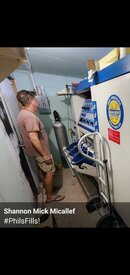Without context I'm not sure what the author is getting at. However, it takes time for partial pressure blends to mix if the gases are added slowly (as they should be). If the tank is analyzed immediately after a PP blend stated with O2 and finished with air the analyzer will often read a lower percentage of O2 than the mix will actually contain afterward. Many people (including me) roll tanks for a minute or so before analyzing. The blender should know what the original analysis was if the tank wasn't empty and know within a percent or so what the final mix should be. If the analysis isn't really close to that, either the blender made a mistake or the gases are still mixing.
This is one reason you must always analyze your gas personally. Most often, you won't do that immediately after the blender has finished, which gives the gases time to mix completely.
I'll add that membrane systems have the same problem unless the tank is completely empty to start with, though the difference between the existing content and the final mix is often smaller.
There have been any number of discussions in the past about whether the mix should "instantly" be complete or whether it takes time. Certainly the time is nonzero, so the real question is "how much time"? I dunno. At least a few minutes, perhaps a few hours if the tank doesn't get moved around much, I mix, roll, analyze, and then analyze again pre-dive. As long as the two analyses agree I'm happy.
Does this help?




